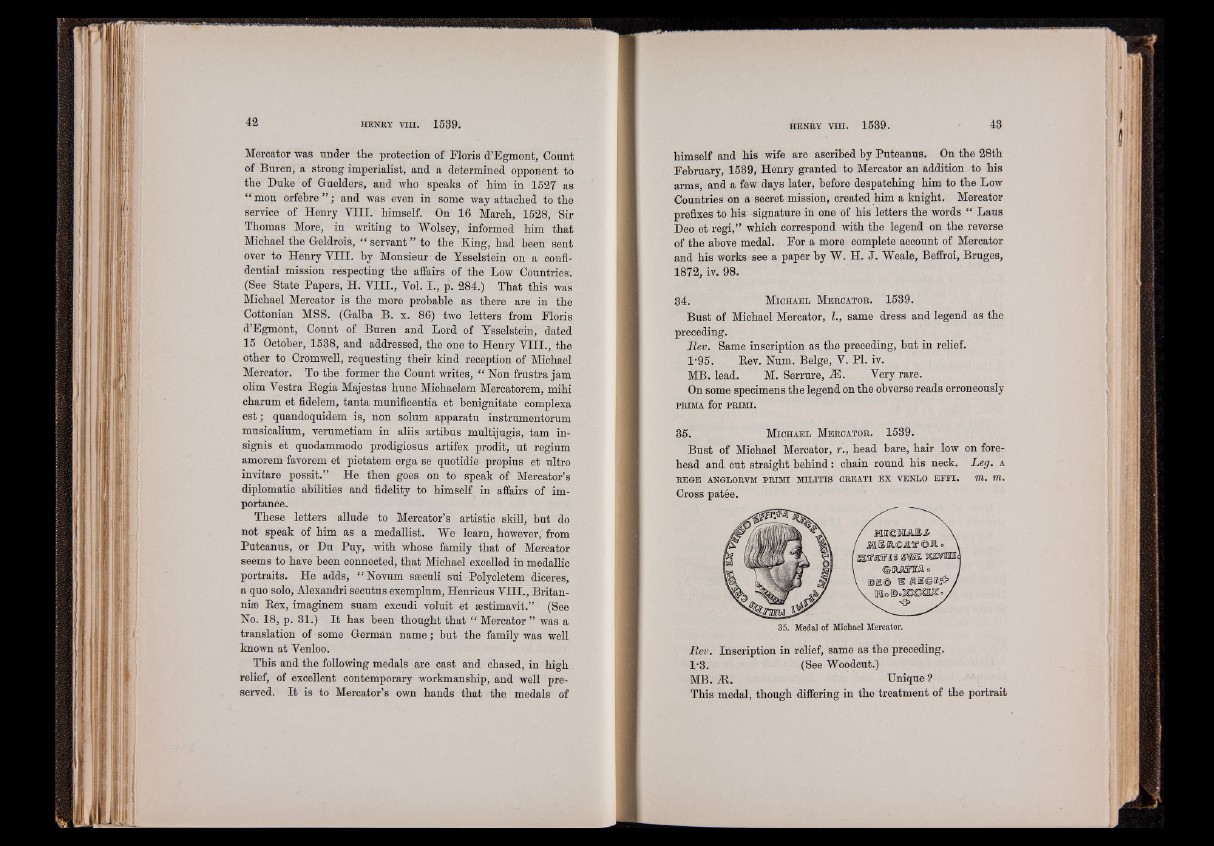
Mercator was under the protection of Moris d’Egmont, Count
of Buren, a strong imperialist, and a determined opponent to
the Duke of Guelders, and who speaks of him in 1527 as
“ mon orfehre ” ; and was even in some way attached to the
service of Henry VIII. himself. On 16 March, 1528, Sir
Thomas More, in writing to Wolsey, informed him that
Michael the Geldrois, “ servant ” to the King, had heen sent
over to Henry VIH. by Monsieur de Ysselstein on a confidential
mission respecting the affairs of the Low Countries.
(See State Papers, H. VIII., Vol. I., p. 284.) That this was
Michael Mercator is the more probable as there are in the
Cottonian MSS. (Galha B. x. 86) two letters from Moris
d’Egmont, Count of Buren and Lord of Ysselstein, dated
15 October, 1538, and addressed, the one to Henry VIII., the
other to Cromwell, requesting their kind reception of Michael
Mercator. To the former the Count writes, “ Non frustra jam
olim Vestra Regia Majestas hunc Michaelem Mercatorem, mi'hi
charum et fidelem, tanta munificentia et henignitate complexa
e st; quandoquidem is, non solum apparatu instrumentorum
musicalium, verumetiam in aliis artibus multijugis, tarn in-
signis et quodammodo prodigiosus artifex prodit, ut regium
amorem favorem et pietatem erga se quotidie propius et ultro
invitare possit.” He then goes on to speak of Mercator’s
diplomatic abilities and fidelity to himself in affairs of importance.
These letters allude to Mercator’s artistic skill, hut do
not speak of him as a medallist. We learn, however, from
Puteanus, or Du Puy, with whose family that of Mercator
seems to have heen connected, that Michael excelled in medallic
portraits. He adds, “ Novum sseculi sui Polycletem diceres,
a quo solo, Alexandri secutus exemplum, Henricus VIII., Britan-
nise Rex, imaginem suam excudi voluit et sestimavit.” (See
No. 18, p. 31.) It has heen thought that “ Mercator ” was a
translation of some German name; hut the family was well
known at Venloo.
This and the following medals are cast and chased, in high
relief, of excellent contemporary workmanship, and well preserved.
It is to Mercator’s own hands that the medals of
himself and his wife are ascribed by Puteanus. On the 28th
February, 1539, Henry granted to Mercator an addition to his
arms, and a few days later, before despatching him to the Low
Countries on a secret mission, created him a knight. Mercator
prefixes to his signature in one of his letters the words “ Laus
Deo et regi,” which correspond with the legend on the reverse
of the above medal. For a more complete account of Mercator
and his works see a paper by W. H. J. Weale, Beffroi, Bruges,
1872, iv. 98.
34. M i c h a e l M e r c a t o r . 1539.
Bust of Michael Mercator, I., same dress and legend as the
preceding.
Rev. Same inscription as the preceding, hut in relief.
P95. Rev. Num. Beige, V. PL iv.
MB. lead. M. Serrure, M . Very rare.
On some specimens the legend on the obverse reads erroneously
pr im a for PRIMI.
35. M i c h a e l M e r c a t o r . 1539.
Bust of Michael Mercator, r., head hare, hair low on forehead
and cut straight behind : chain round his neck. Leg. a
REGE ANGLORVM PRIMI MILITIS CREATI EX VENLO EPEI. Itl. m.
Cross pâtée.
35. Medal of Michael Mercator.
Rev. Inscription in relief, same as the preceding.
1*8. (See Woodcut.)
MB. JR . Unique?
This medal, though differing in the treatment of the portrait